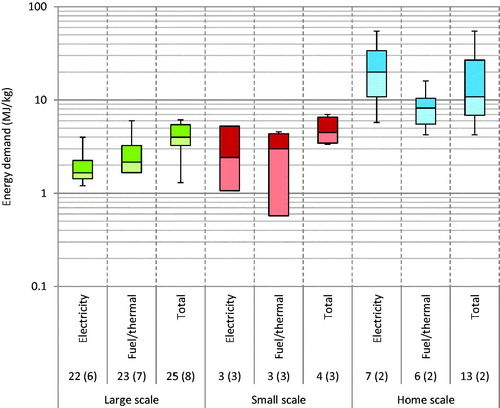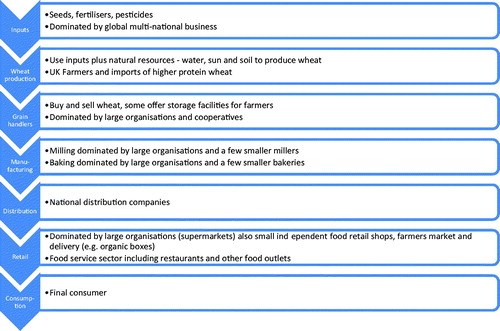Abstract
Addressing the intersection of two important emerging research areas, re-distributed manufacturing (RDM) and the food-energy-water (FEW) nexus, this work combines insights from engineering, business and policy perspectives and explores opportunities and challenges towards a more localized and sustainable food system. Analysis centred on two specific food products, namely bread and tomato paste reveals that the feasibility and potential of RDM vary with the type of food product and the supply chain (SC) components. Physically, energy efficiency, water consumption and reduction of waste and carbon footprint may be affected by scale and location of production activities and potentials of industrial symbiosis. From the business perspective, novel products, new markets and new business models are expected in order for food RDM to penetrate within the established food industry. Studies on policies, through the lens of public procurement, call for solid evidence of envisioned environmental, social and economic benefits of a more localized food system. An initial integrated framework is proposed for understanding and assessing food RDM and the FEW nexus.
1. Introduction
Today, 80% of food by value purchased in the UK is processed or manufactured (DEFRA Citation2013). Only a small proportion of supermarket shelf space is devoted to fresh fruit and vegetables and lightly processed products such as fresh meats. Food manufacturing is UK’s largest manufacturing sector with a gross value added (GVA) of £26.5bn (DEFRA Citation2015), employing 400,000 people at 9600 sites across the country. The sector grew massively over the course of the 20th century, increasing in scale and complexity and moving from a system of relatively localized small manufacturers to a globalized industry largely controlled by multinational corporations. Nonetheless, there are checks on the centralization of food manufacturing, not least the desire from consumers for freshness, quality, transparency and cultural specificity, and concerns about power concentration by a few multinational corporations, which help keep the food industry more widely distributed than some other manufacturing sectors. Moreover, concerns about environmental sustainability and climate change are drivers to study alternative food supply systems. Food systems comprise at least one manufacturer of processed food, but also include the broader group of actors such as farmers, suppliers and consumers related to the specific product.
The redistributed manufacturing (RDM) concept suggests that the future might hold at least a partial reversal of the historical trend towards centralization, and that this could bring associated environmental and social benefits. Innovative developments in a variety of sectors around new technologies such as additive manufacturing (3D printing) are at the forefront of such claims, but it could also involve more – but lower technology operations – such as artisanal bakeries. Little work has focused on what this would mean for the food sector, however.
Food systems are highly intertwined with energy and water systems, also known as the food-energy-water (FEW) nexus, therefore, assessments of RDM of food should embrace a holistic approach.
The Local Nexus Network (LNN) is a research project in which a multidisciplinary team of researchers from different research groups across the UK work together on addressing the intersection of two important emerging research areas: RDM and the FEW nexus. It is an on-going initiative which aims to develop an evidence-based comprehensive research agenda and foster an inclusive community of researchers, businesses and stakeholders. Conceptual framing and preliminary results of the project have been presented in Cottee et al. (Citation2016). This paper is a follow-up and explores the opportunities and barriers for combining the area of RDM and the FEW nexus. A multidisciplinary perspective is adopted, combining insights from engineering, business and policy to explore existing opportunities and challenges towards a more localized food system. First, we start with a brief discussion about the two central themes in this study, namely RDM and the FEW nexus. We then outline the overarching methodology adopted in this work. This is followed by a presentation of an understanding of the current situation in the UK regarding two food products. Subsequently, these two food products are discussed in the context of RDM and the FEW nexus from a physical, socio-economic and political perspective. The next section synthesizes the opportunities and challenges before the conclusions are presented.
2. Background: RDM and the FEW nexus
2.1. Redistributed manufacturing
While RDM is a novel coinage, it has affinities with the more widely used terms ‘distributed’ and ‘decentralized’ manufacturing. All of these ideas revolve around the changing location and scale of manufacturing activities, such that manufacturing units are of greater number, are therefore relatively smaller, and are located closer to the consumer of the final product. Recent interest in RDM has been driven by a number of factors including new technologies, considerations of environmental sustainability, rising logistics costs and changing global economies (Matt, Rauch, and Dallasega Citation2015).
Much focus of RDM has been around new technological innovations such as additive manufacturing (3D printing) and computer numerical control (CNC) manufacturing, but despite some experimentation with 3D-printed food by chefs and entrepreneurs, little attention has so far been paid to the wider implications of RDM for the food sector. More generally, RDM for food can be considered as the reorganization of food manufacturing so that it occurs in smaller units closer to the consumer. This prospect raises at least three central questions:
What would be the drivers of such a reorganization of food manufacturing?
What would be the necessary technological, organizational and regulatory facilitators1 of such a change?
What would be the consequences (intended and unintended) of such a change?
Work on RDM in other sectors already suggests some hypotheses for each of these areas. With regards to drivers, for example, EPSRC2 proposes that there is a ‘drive towards smaller scale manufacturing caused by changes in transport and labour costs, the availability of materials and energy, the need for sustainability, the availability and cost of small-scale equipment, and access to information’. In the 2013 EPSRC-ESRC3 workshop on RDM, Pearson et al. suggest that these changes are, or will be, associated with ’new advances in materials sciences, engineering, “smart” and flexible machining and digital and enabling technologies’. The same report sees a RDM world as requiring new business models and training and marketing strategies, and implying greater personalization of products, while the EPSRC-ESRC-funded project Future Makespaces in Redistributed Manufacturing imagines the potential for radical creativity and artisanship supported by new technologies (RCA Citation2016).
There is also the argument that RDM includes manufacturing in the home which presents further opportunities. In terms of sustainability, RDM is considered to have the potential to offer greater resource utilization, reducing the carbon footprint of the SC through local production and local markets, as well as the ability to create models which address the need for re-use and re-manufacturing of components, and factor in ethical practices (Foresight Citation2013; Garetti and Taisch Citation2012).
There are, however, a number of challenges that present themselves such as maintaining supply for mass markets and ensuring the optimal use of resources. Key driving factors of whether business will engage in RDM will be the cost of investment, the expected returns and the risks involved. At the same time, upcoming companies focusing on RDM could pose a risk to incumbent players which could lose market value if they do not adapt to the changing business landscape.
2.1.1. RDM of food
Food products are a distinct category of products (Rosset Citation1999). Food is one of the basic needs of humans and affordable food availability is essential for political stability (Ericksen Citation2008). Food products are bound by strict health and safety regulations. Furthermore, food serves various functions in addition to nutrition (e.g. social) and shares different values (e.g. vegetarian, halal) (Ericksen Citation2008; Vellema, Loorbach, and Van Notten Citation2006). Also, consumer acceptance or rejection of new food technologies such as 3D printing will influence the speed of adoption of RDM in the food sector (Siegrist Citation2008; Henson Citation1995). Therefore, RDM of food products may be more constrained as compared with other products, yet it could harness opportunities which arise only in the food sector because of the specific features of food, such as freshness and food waste.
RDM has the potential to open up new possibilities for both existing and new players within the food SC as its full potential and implications are not yet well understood in any area of manufacturing (Gao et al. Citation2015; Kietzmann, Pitt, and Berthon Citation2015). In the production of food, key drivers such as climate change, resource scarcity, employment, health issues and environmental concerns underpin the need for exploring RDM and its impact on regions ranging from resource usage (water, energy and other natural resources), to the need for greater sustainability on three levels – environmental, economic and social. Another set of drivers include demand for more ‘locally produced’ food, food security and shorter food SCs; leading to products being more tailored to the needs of consumers. RDM therefore offers the potential for entrepreneurs to start-up new businesses using new technology that could be highly efficient.
2.2. The Food-Energy-Water nexus
Collectively, food, energy and water represent intertwined challenges faced by today’s and future societies, and often linked with wider issues. For example, cities form sinks of food waste, waste water and waste heat and increased transport adds to air pollution and related health issues. Furthermore, urbanization creates an imbalance in nutrient cycling, leading to soil depletion and an overabundance of nutrients in water sources (Grimm et al. Citation2008).
Managing the food-energy-water nexus is recognized by the UN as an important pathway towards a more sustainable and resilient world (Flammini et al. Citation2014). Due to the interdependencies between the three sectors, taking actions on an energy system or a food-energy system alone could potentially have a negative impact on the other area(s). The nexus approach acknowledges some of these negatives side effects by incorporating a holistic view.
The complexity and scale of the interactions in the FEW nexus are significant. The difficulty here is finding the right balance in system boundaries such that it includes all relevant aspects while keeping it sufficiently tractable to carry out useful analysis (Bazilian et al. Citation2011). To measure the impact of potential improvements of the current food production system, it is key to determine the most important metrics and define the methods to measure them. A study by Irabien and Darton found that the application of the carbon footprint, water footprint and chemical footprint as indicators allows a quantitative assessment for the food production system (Irabien and Darton Citation2016).
In general, the nexus relates to a large extent to trade-offs, although in some areas interesting synergies could work to enable co-improvement of multiple activities through rational integration.
2.3. The combined area of RDM and the FEW nexus
RDM could play a role in encouraging local low carbon businesses and potentially an overall reduction in greenhouse gas emissions. Having a wider geographical spread of food manufacturing can be positive in socio-economic (e.g. job creation) and also in environmental terms because renewable energy and water sources may be more easily used at the local level (e.g. greenhouse tomatoes grown in the UK using waste energy from another industry may also use local water resources with lower embedded energy). However, when considering RDM for food products, down-scaling and decentralising manufacturing may have the opposite effects and could result in greater energy and water consumption due to the loss of economies of scale and logistical problems, hence the need for analysing various scenarios and SCs from the point of view of energy and water usage.
The long lasting discussion whether large scale (i.e. large fields, large machinery) agriculture is better, in terms of environmental sustainability, than small scale agriculture is interesting and many studies have addressed this topic from different angles. For example, Peter Rosset studied the benefits of small farm agriculture and argues that small farms could reduce the use of herbicides and could produce a higher total output per area, although the yield (e.g. tons per hectare) of a single crop might be less (Rosset Citation1999). The study by Ghosh (Citation2014) shows that home gardens could also play a role towards a more sustainable food production system. The influence of farm scale on ecosystems is mixed due to complex interactions and depends on many variables (Gabriel et al. Citation2010). Regarding productivity, most studies conclude that many factors play a role and that farm size alone is not a suitable measure (Gorton and Davidova Citation2004; Fan and Chan-Kang Citation2005).
Related to this debate is the ongoing discussion on advantages of local food, which has also became more complicated due to mixed perceptions and vague definitions (Weatherell, Tregear, and Allinson Citation2003; Brunori et al. Citation2016). Moreover, most of the studies assessing local food products consider fresh produce and some meat products; relatively few focus on processed food products (Edwards-Jones Citation2010). In general, local food systems are not per se better for environmental sustainability (Born and Purcell Citation2006; Edwards-Jones Citation2010; Avetisyan, Hertel, and Sampson Citation2014). Although the public presumption is often that local food is reducing greenhouse gas (GHG) emissions, which is supported by the widely used and misleading term ‘food miles’, this is often not the case in today’s globalized economy (Edwards-Jones Citation2010; Avetisyan, Hertel, and Sampson Citation2014). Moreover, increased food miles could eventually result in lower overall emissions (Coley, Howard, and Winter Citation2009).
The discussions on agricultural production scale, local food and food miles show that environmental sustainability of local and small-scale food production is a complex issue for which simple answers do not exist. However, investigating food RDM within the context of FEW nexus may bring useful insights to this topic.
3. The overarching approach
In this study, opportunities and challenges for food RDM and its consequences on the FEW nexus are investigated. With the scope, this work focuses on manufacturing of processed food products and on the impact on environmental sustainability, without addressing extensively the agricultural system and the wider spectrum of sustainability. The analysis is carried out from three different angles, namely the physical, socio-economic, policy perspective.
Although RDM allows for a broader interpretation, for this study we assume that RDM is equivalent to decentralized manufacturing, referring to numerous smaller localized manufacturing sites compared with the prevalent few large centralized manufacturing sites at present.
To assess the effect of RDM on the FEW nexus, two food products have been selected for the LNN feasibility studies, namely: bread and tomato paste. These have been chosen because they are both processed food products and have distinct water and energy demands. Moreover, the current manufacturing of these two products presents contrasting degrees of decentralization, with bread production being much more decentralized than the production of tomato paste. Another factor considered for tomato paste is that although it is mainly produced in regions with a warmer climate than the UK, climate change could exacerbate the water stress in these regions which in turn could cause interruptions in the supply or could lead to increased prices. Using the matrix comprising the two case study food products and the three (physical, socio-economic, policy) perspectives, an understanding of the current systems is obtained, and their RDM futures are examined. Based on the findings of these studies, the potential impact of RDM in the food sector and implications on the energy and water consumption will be evaluated.
Data have been collected from literature, from interviews with various (local) actors along the food value chain, focus groups and workshops. The large-scale nature of the project enabled us to engage with a large amount of stakeholders over a period of two years (2015–2017), which generated a vast amount of empirical data. Overall, 29 interviews with local food producers, suppliers and retailers were conducted, as well as 5 workshops, 14 focus groups and a written survey with 96 returns. The use of multiple data sources helped establish a detailed narrative of the 2 cases and a strong chain of evidence (Karlsson Citation2009). The use of different data sources also helped increase construct validity through triangulation (Edmondson and McManus Citation2007). In terms of data analysis, the items presented in the findings section below evolved and developed in multiple cycles and often required new supporting evidence until they became refined and emerged as a robust outcome of the research. Pattern matching (Trochim Citation1985) was employed in order to offer strong multi-perspective coverage and matching, particularly of self-reinforcing mechanisms. To avoid concept force fitting, further relevant literature was critically appraised, as detailed in the following sections.
4. Current situation of food manufacturing in the UK: the case of bread and tomato paste
4.1. Bread
4.1.1. The product
In this study, bread refers to unsweetened, leavened loaves, which weigh about 800 g, as commonly consumed in the UK. Typically, primary ingredients in the bulk of UK bread are wheat flour and water which is added to flour to form dough. For a loaf, approximately 536 g of flour and 328 g of water are required. The wheat grain to flour conversion ratio depends on the type of flour used, varying in between roughly 100% for whole-wheat flour to 75% for white flour.
4.1.2. Manufacturing process
Bread manufacturing is generally divided into two parts: milling and baking. The milling stage transforms grain (mainly wheat) into flour; the baking stage includes the addition of water, yeast, salt and other ingredients, and heat.
There are four stages common to all baking processes: (1) mixing, (2) proving/fermenting, (3) baking and (4) cooling. There are two main variants used in commercial bread production in the UK, the Chorleywood Bread Process (CBP) and the more traditional Bulk Fermentation Process (BFP). The more energy intensive CBP reduces the fermentation time and is the standard process in modern large scale bakeries (The Federation of Bakers 2017; The National Association of British & Irish Millers Citation2011).
4.1.3. UK supply chain
The SC for bread is made up of eight key stages: agricultural input, agriculture (cereal growing), grain handling, milling, baking, distribution, retail and consumption.
The wheat-to-bread SC is interesting because of the variety of different scenarios in terms of where production, manufacture and retail take place across the entire spectrum of geographical scales, from the global to local scale. The global chain is characterized by large multinational corporations and large wheat buying co-operatives whereas the local chain is smaller and focuses on small scale niche products where wheat is often milled, turned into bread and retailed within a particular locality.
The predominant UK wheat-flour bread chain (see ) is highly intensive, industrial and, beyond the farm gate, very centralized. Over the years, as centralization has taken hold of the industry a very large number of small, artisan bakeries were displaced by large scale centralized bakeries using high-tech methods to produce bread for the mass market with productivity the key driver for success (Decock and Cappelle Citation2005; Sharpe, Barling, and Lang Citation2008). Current bread is the product of intensive cultivation and a concentrated and highly industrialized manufacturing and distribution system with 80% of bread produced in so-called plant bakeries (Barling, Sharpe, and Lang Citation2009). More specifically, the UK industrial bread sector is being dominated by 11 companies, operating 51 factories (Sharpe, Barling, and Lang Citation2008). There is strong vertical integration between millers and bakers, with the two largest plant bakers, Allied Bakeries and British Bakeries, owned by millers: Associated British Foods and Rank Hovis MacDougal, respectively (Barling, Sharpe, and Lang Citation2009). The three largest manufacturers in the plant baking sector are Allied Bakeries (Kingsmill), Premier Foods (Hovis) and Warburtons. These three manufacturers account for almost ¾ of the bread market by value (The Federation of Bakers 2015).
Another important part of the bread SC is the frozen dough and part-baked dough allowing retailers to sell fresh bakery products all day (Inoue and Bushuk Citation1992), 17% of this type of bread is produced in an estimated 1,500 ‘in-store bakeries’ (ISBs) with all the large multiple retailers having one in all or most of their stores; these are located in retail outlets and may either bake bread completely on-site or use factory-made dough, supplied frozen, partly or fully baked, which is then given a final baking on-site called ‘bake off’ products (The Federation of Bakers 2015; Barling, Sharpe, and Lang Citation2009). The expansion of in-store bakeries has been at the expense of the smaller artisan bakery.
Coexisting with this dominant chain (and dependent on it for some inputs and services) is a comparatively small ‘craft’ chain (or series of chains) characterized by smaller production units. These ‘craft’ bakeries, amounting to 3% of bread by volume (Barling, Sharpe, and Lang Citation2009; Mintel Citation2015; Fabflour 2016a, Citation2016b; The Federation of Bakers 2015; Sharpe, Barling, and Lang Citation2008), are less mechanized and use more time-consuming, traditional manufacturing methods, using fewer inputs or additives to facilitate production (Barling, Sharpe, and Lang Citation2009; Sharpe, Barling, and Lang Citation2008). Independent bakeries are just beginning to re-emerge using local produce, employing local people and boosting regional economic development (Sustain Citation2016).
Another important avenue for bread sales is the food service sector with around 5%–10% being sold for consumption outside consumers home (The Federation of Bakers 2015). In terms of bread exports, this represents a small amount of the market but there is an increased demand from the European market for fresh sliced bread (mainly for sandwich making) and part-baked and frozen products (The Federation of Bakers 2015). Also note that less than 1% of bread consumed in the UK is imported (Mintel Citation2015; The Federation of Bakers 2015; Sharpe, Barling, and Lang Citation2008).
Packaged sliced bread is bought in most large retail outlets, with white bread being the most popular. Dewettinck et al. (Citation2008) identify trends in bread industry: fresh-baked and artisan products are still very popular but mass-produced specialty breads are strong competitors. Breads containing whole grain, multi-grain or other functional ingredients are becoming more important (see also Van Der Kamp et al. Citation2014). The emergence of life stage nutrition (i.e. products formulated to reflect the nutritional requirements of particular consumer subsets, e.g. children or women) is expected to be the path of various initiatives and innovations, including bakery products (Dewettinck et al. Citation2008).
4.1.4. Energy and water consumption
Looking at the complete bread SC from wheat cultivation to bread consumption in the UK, the processes causing the largest CO2 emissions are wheat cultivation and consumer behaviour (Espinoza-Orias, Stichnothe, and Azapagic Citation2011). The latter shows large variations depending on how the bread is stored (e.g. frozen) and consumed (e.g. toasted), if consumed at all, because data from WRAP (Citation2013b) suggest bread waste to be around 25–30%. From the manufacturing perspective, the baking process is the most interesting part to look at. Data from literature show large variations in energy use per kg bread. Although bread baked at large industrial scale tends to be more energy efficient, this is not always the case (see ).
Figure 2. Primary energy consumption in baking bread in MJ/kg, for large industrial, smaller scale and home baking. Data include measurements and results from LCA studies from various literature sources (Masanet, Therkelsen, and Worrell Citation2012; Espinoza-Orias, Stichnothe, and Azapagic Citation2011; Thomsson Citation1999; Carbon Trust 2010; Andersson and Ohlsson Citation1999; Braschkat et al. Citation2004; Beech Citation1980; Le-bail et al. Citation2010). The number of cases is shown below each boxplot, with the number of literature sources shown within brackets.

The Carbon Trust (2010) study found that the average value is around 3.9 MJ/kg primary energy (based on 218 kWh/tonne electricity, 551 kWh/tonne fossil fuel and an assumed electricity generation efficiency of 40%). The same study shows that efficiency seems to be linked to optimum technology and practices, not to scale of production.
In the whole bread SC, most of the water (∼95% (WRAP Citation2013a)) is used in the cultivation of wheat. Because of the high yield in the UK, the water footprint for wheat is one of the lowest in the world; the global average is 1608 m3/tonne wheat whereas the water footprint for the UK is estimated to be 522 m3/tonne (Mekonnen and Hoekstra Citation2011). Besides, due to the favourable climate in the UK allowing for rain-fed cultivation, most of this water footprint is regarded as green water.4
During the milling process, water is added to soften the wheat, making it easier to process. The amount of water used within the process is approximately 1% of total weight of wheat. For baking bread, water is combined with flour to form dough and accounts for the second most important ingredient by weight. However, the total water used in baking bread is insignificant compared to the amount used for growing wheat.
4.2. Tomato paste
4.2.1. The product
Tomato paste is a considerably different product compared with fresh tomatoes. Firstly, it is a concentrated form of tomatoes, increasing the density and thus decreasing the volume of the product. This allows for more efficient shipping which favours production locations with a favourable climate, such as Italy. Besides, tomato paste has been sterilized and can therefore be stored for a longer time. This creates the opportunity to better balance supply and demand, allowing for more stable prices and therefore less risk. In general, the variety of tomatoes used for tomato paste, plum tomatoes, is harder in consistency allowing mechanical harvesting and transportation (Lindsey Citation1977; Carlisle-Cummins 2015).
4.2.2. Manufacturing process
Production of tomato paste can be divided into two main parts: tomato cultivation (primary production) and tomato processing (manufacturing). Processed tomato (e.g. paste, puree and ketchup) is basically produced by removing the seeds, skin and pulp of tomatoes to create a tomato juice which is then thickened, normally by evaporation (Gould Citation2013).
4.2.3. UK supply chain
Currently, all tomato paste consumed in the UK is imported from other countries because of the logistic advantages of tomato paste over whole tomatoes. Some of the imported ‘prepared or preserved’ tomatoes will be exported to other countries, see . The total mass of tomatoes produced in the UK in 2012 is around 84,000 tonnes (Brad et al. 2015), which is less than 20% of tomato demand in the UK and the rest is imported from other countries, mainly from Italy, Portugal and Spain. The international SC consists of agricultural inputs, agriculture, manufacturing, distribution, retail and finally consumption.
Table 1. Net import and export of prepared or preserved tomatoes by the UK in 2014 (Harvard University 2016).
Tomato paste will also be part of other food SCs as an ingredient, for example, pizza, ready-made pasta sauces amongst others. The EU accounts for one-third of world output of processed tomatoes. Major production regions outside Europe include California (US), Turkey, China and Thailand (Pritchard and Burch Citation2003). Tomatoes for processing are sourced from relatively large farms specialized in extensive production of arable crops and vegetables (Roza and Bunte Citation2007). Therefore, its market is interlinked with other horticulture products.
4.2.4. Energy and water consumption
For growing tomatoes in the field, substantial amounts of energy may be required for pumping water from the ground or surface water body directly for irrigation, and also for pumping from the ground or water body, treatment and distribution through the pipes network for irrigation, if water comes from a centralized water supply organization.
Large scale tomato paste processing plants work intensively (typically 24 hours a day during the tomato season), first sorting and washing tomatoes which are mechanically harvested. Energy is required for the mechanical collection and transportation processes and for treating and pumping water for the washing stage. Energy requirements in some of the above phases are reduced in small scale and artisanal production lines where some of the processes are done by hand.
Tomatoes are then crushed and heated to form a pulp. This pulp is further heated to a hot (98–100 °C) or cold (60 °C) point that results in a more or less viscous paste, respectively. These phases require substantial energy inputs. The pulp is put through screens with some energy input in this process and then a vacuum evaporator, requiring heat input, is used to thicken the paste, which is subsequently sterilized and rapidly cooled.
Finally, in the production process, wastage is often dried and used to feed dairy cattle, for pet food or is sent to landfill. There is therefore also potential for this waste to be used to feed decentralized combined heat and power plants (CHPs) to generate energy locally.
Although there is no tomato paste produced in the UK, the water footprint of potential tomato paste production in the UK is relatively low: a study by Mekonnen and Hoekstra (Citation2011) shows that this is 50 m3/tonne in the UK whereas the global average is 855 m3/tonne.
Water is used for many different steps and purposes of a typical tomato processing facility. Within the processing phase, the main components which consume water are unloading and washing (88%) and concentration and pasteurization (9%) chopping, blenching, refinement and filtration (2%) and filling and bottle pasteurization (1%) (Manfredi and Vignali Citation2014).
5. The future of food RDM and the FEW nexus in the UK
In this section, the challenges and opportunities of applying RDM for food products in the UK and its impact on the FEW nexus are discussed from a physical, socio-economic and policy point of view.
5.1. Physical perspective
5.1.1. Implication of RDM on energy, water and land
Within the whole SCs of the two products examined, bread baking is probably the process step holding the greatest potential from both the RDM and the FEW nexus perspectives. Although wheat cultivation could be done by small farms, it is predominantly done by large farms in the UK, likely due to economic incentives (Wilson, Hadley, and Asby Citation2001). Also, the location of wheat production is hard to redistribute (e.g. due to favourable climate, existing infrastructure), furthermore with existing technology milling is done efficiently at a large scale and redistributing offers no clear benefits. From the energy perspective, the baking process could be redistributed, since the data presented in section 4.1.4 suggest that the baking at a smaller scale (e.g. city scale) could result in similar energy demand per kg of bread produced. However, baking bread at much smaller scale (e.g. artisanal, and especially home baking) would require more energy. This increase in energy use during the baking process results from a combination of less efficient technologies and the degree of oven loading, especially for baking bread in private homes. Water consumption during bread manufacturing is relatively low and it is expected that redistributing bakeries would not cause a significant difference. Although distributing raw materials to a large number of smaller bakeries requires more transportation, this partly replaces the current daily transportation of fresh bread from centralized locations. Moreover, transporting flour can be done more efficiently than bread, because of (1) the difference in density and (2) the frequency of distribution trips will lessen since the raw materials can be stored for a longer time than bread. Also a change in commuting of employees to centralized bakery plants could have an impact. The shorter transportation distances can potentially accelerate the uptake of electric vehicles, which are currently limited by their action radius. The total carbon footprint of decentralized bakeries compared with the current centralized system should therefore be carefully analyzed in the future.
Increasing the number of bakeries closer to the consumer would mean that more land is required for bakeries in urban areas. Although this may not be a major issue in most cases, it could form a barrier to create a feasible business case in areas with limited spaces and high land prices.
Producing tomato paste in the UK seems unlikely to become attractive because of the unfavourable climate for producing tomatoes. On the other hand, a study of Spanish tomato production showed that the water availability, access and utilization is among the main risks (Irabien and Darton Citation2016). Therefore, opportunities may arise when water stress becomes more prevalent in the present production locations due to climate change or other developments (e.g. higher water demand due to population growth). Since the water footprint of tomatoes in the UK is relatively low, the UK might become a better location to grow tomatoes in the future. However, this would have implications for land use, since growing tomatoes requires a lot of space.
5.1.2. Opportunities of RDM on waste
Bread waste is a major issue, according to a report by WRAP (Citation2013b) up to 660,000 t (£640 million) of bread is wasted in the UK every year. The bread waste, once generated, can be converted into energy. Anaerobic Digestion (AD) of food waste is becoming an alternative for energy generation in the UK and could represent between 3.8 and 7.5% of the renewable energy that it is estimated we will require in 2020. Digesting 1 tonne of food waste can generate about 300 kWh of energy (The Official Information Portal on Anaerobic Digestion Citation2016). Therefore, AD of 660,000 tonnes of bread wasted in the UK every year could result in 198 GWh being generated per year in the UK. This represents approximately 10% of the current total energy used in the sector (2000 GWh, as reported by the Carbon Trust (2010)). In addition, there would be a valuable digestate usable as fertilizer, which could support local recycling of nutrients.
Trying to redistribute food before it gets wasted and using food waste for animal feed seems to be a better strategy compared to the waste-to-energy approach. This is part of the Courtauld Commitment 2025 by WRAP, ‘a voluntary agreement that brings together organizations across the food system to make food and drink production and consumption more sustainable’ (WRAP Citation2016). With RDM, a more effective approach would be allowing all the purchased breads to be actually consumed by the purchasers. This may be derived from the increased attractiveness of the product in terms of freshness and localness, smaller sizes of a single purchase, or the combination of the two. The potential benefit of avoiding bread waste can be seen through the lens of energy: Assuming an energy intensity of 800 kWh/t of bread for baking,5 528 GWh in energy savings per year could be achieved in the UK based on baking alone, excluding other savings in the value chain. This represents approximately a quarter of the current total energy used in the sector (Carbon Trust 2010). Taking into account all the other steps in the bread SC, the embedded energy that can potentially be saved is even higher.
5.1.3. RDM and synergetic systems
Relocating bakeries near other energy intensive industries could potentially create synergies by reusing the waste heat from other processes. However, the number of industrial plants working with high temperatures is relatively small compared with the number of bakeries. A heat network might be more practical to achieve such synergies, allowing multiple heat suppliers and consumers to connect to it, which could balance the heat demand and supply. However, this is only feasible when there is excess heat without alternative use. Moreover, high investment costs and long-term commitment are often barriers to the implementation of such networks.
5.2. Socio-economic perspective
5.2.1. RDM of bread and tomato paste in the UK
Redistributing bread manufacturing is possible for certain components of the value chain – for example, regionally grown raw ingredients, milling, baking and retail. Re-distributed bread making value chains can co-exist with more centralized mass production which offers consumers with variety in terms of pricing, products and product experience.
Currently, the bakeries are highly centralized and are able to produce industrialized bread at low cost due to economies of scale. It is hard for start-ups to compete on the basis of cost; however, other aspects such as freshness, customized portions (i.e. less waste) and personalized ingredients (e.g. linked to health issues) might offer opportunities and also command a higher price.
Regarding tomato paste, there is not currently a sustainable business for RDM in the UK. The barriers to entry the UK market are too high both economically and environmentally and creating the desirable conditions would result in higher costs for the final product.
5.2.2. New business models and new markets
There are untapped market niches for personalized, customized and innovative products. These need to be produced in small batches or even as unique pieces. Such demands cannot be satisfied by the mass standardized products that low cost economies have completely captured. Such niche markets require customers to co-innovate or even co-produce with the manufacturer or the maker, for example, specialist bread or customers deciding what seeds to add to grained and seeded loaves; it may also be feasible for customers to order specialized breads to their own particular dietary requirements or to suit their taste preferences and collect these e.g. from a local bakery. Innovations in the development of life stage nutrition and the need to develop nutritional based products are required to meet growing demands (Dewettinck et al. Citation2008). RDM could assist in future developments of this area.
Another possibility for RDM in the food SC would be the use of technology to allow for small scale recycling of food waste; for example, taking local fresh produce ‘waste’ (e.g. at the retail level) and other ingredients then processing into ready-made meals which can be sold or run as a charitable organization for individuals in need of food. As this is small scale and on-demand, end products could be customized as to the availability of ingredients each day. This would result in an addition to the current business model whereby the value chain would include another step from retailer to a food recycling manufacturer before reaching the consumer.
The increased availability of ‘open data’ could also offer new opportunities for food manufacturers operating closer to the market to respond faster to changes in consumer demand and to the need for product innovation (Öberg and Graham Citation2016).
5.2.3. Shared services
One of the benefits of economies of scale is related to overhead costs which are embedded in the price of the product. Therefore, the more products a company sells the lower the additional costs related to these overhead costs will be. RDM of food products could be leveraged by using shared facilities so that small scale companies are still able to enjoy these benefits associated with economies of scale.
An example is the recent growth in UK food delivery services such as Just Eat and Deliveroo, allowing consumers to order dishes from local restaurants online which will be delivered to a specific location (e.g. home). For local restaurants, having their own delivery service may not be cost-effective, however, using such a shared service allows all local restaurants to enter this new market and compete with larger existing players. This can stimulate locally manufactured food while combining digital technologies to meet customers on demand.
New businesses could evolve around this theme, offering shared services to local food companies (Bloom and Hinrichs Citation2011). This could be related to (cold) storage of food ingredients/products, legal service office supporting local companies complying with (food safety) regulations or shared insurances to minimize (the cost of) risks. Lelah et al. (Citation2012) proposed a business model for collaborative networks for SMEs to increase the sustainability of products and services. Although this offers benefits as reduced risks and investments and thus lower barriers to enter the market, drawbacks can be lack of trust, proprietary issues and dependency on other SMEs in the network and on the shared system provider.
5.2.4. Consumer preferences
Consumers play a vital role in the successful implementation of RDM and the overall sustainability of a particular product or service. Are they willing to change their shopping habits, diet and behaviour (e.g. food storage, waste prevention, recycling practices, food preparation techniques) or accept higher prices for more sustainable products? Many studies have been performed to analyze consumer perceptions and behaviour in relation to local food. In general, consumers’ preferences and behaviour are very heterogeneous and their attitude and actions towards local food depend on many factors such as values and beliefs, knowledge, resources and willingness to pay (Adams and Salois Citation2010).
Megicks, Memery, and Angell (Citation2012) surveyed consumers in the UK to identify a set of drivers of and inhibitors to local food buying and found that support for local business and provenance of the food are the most influential drivers for buying behaviour and intentions and that wider ethical and sustainability issues did not play a significant role. A study by Tobler, Visschers, and Siegrist (Citation2011) confirms that environmental factors are not enough to change consumers’ food consumption behaviour and the same counts for food miles (Kemp et al. Citation2010). Tobler et al. (Citation2011) note that this can be partly attributed to a lack of knowledge, but they argue that a change could be encouraged by campaigns which include non-environmental benefits such as proven health and taste claims. In contrast, Khan and Prior (Citation2010) found that urban UK consumers are generally confused about the meaning of the term ‘local’ food and that support of local producers was not regarded as important. This difference in rural/urban consumers has also been suggested by Weatherell, Tregear, and Allinson (Citation2003). Furthermore, Khan and Prior (Citation2010) found that the most common barriers for urban consumers to purchasing local food were ‘too expensive’ followed by ‘not readily available’ and ‘no time to find it’, results confirmed by a study from Chambers et al. (Citation2007). Moreover, Khan and Prior (Citation2010) conclude that understanding, information, availability and access to local food emerge as the biggest challenges to urban consumers in buying local food.
Scholderer and Grunert (Citation2005) analyzed consumption patterns in relation to convenience regarding food. Convenience in food comprises saving time, physical energy or mental energy during various consumption stages such as planning, purchasing and preparation. The authors found that convenience behaviours are strongly linked to perceived monetary and time resources and the consumers’ attitude towards time and personal energy spending on food preparation. From this perspective, it is suggested that many consumers would continue to prefer one-stop shopping to buy other food products as well. Food delivery services might tap into the desire of the consumer for convenience, which may also help to reduce the carbon footprint (Coley, Howard, and Winter Citation2009). On the other hand, small local retail stores can also act as a centre for social and community activity, which might be an underplayed consumer benefit (Baron et al. Citation2001).
5.3. Policy perspective
The UK has no specific policies in place regarding RDM of food. The UK government stimulates an open economy and a free market, which favours production locations resulting in the overall lowest cost for a certain product. If there is evidence that local food products provide societal benefits, the UK government could regulate the food sector such that local production increases.
One of such regulations could focus on the public sector. The public sector through national governments and agencies and organizations at a local or regional level have the potential directly to encourage, enlighten and enforce more sustainable procurement through their publicly funded power of purchase and by encouraging their suppliers to procure more sustainably. Through such procurement practices this could in turn be expected to influence the behaviour of some of their clients (pupils and parents in the case of school meals, patients in the case of hospitals, etc.) thereby stimulating the local market for local and sustainable food. The value of public procurement support for locally produced and sustainable food has become politically and academically contested with campaigners and academic champions supporting environmentalists and others supporting global food corporation interests.
5.3.1. Current policy landscape relating to local procurement
Between the start of the new millennium and 2008, a patchwork of local procurement strategies emerged across the globe (Morgan Citation2008; Lang Citation2010). Since 2008 and following the global financial crisis and recession, food procurement managers have been faced with staffing cuts and changing roles and responsibilities, mounting budgetary pressures and a growing array of performance targets in relation to nutritional standards, animal welfare and food safety.
Public sector procurers are increasingly pressed to reduce costs and do ‘more with less’. Consequently, the supply of food and catering services to the public sector has become increasingly dominated by a few large companies that are national or international and able to achieve economies of scale through their SCs and their integration of services.
A critical element in enhancing localization and more sustainable food procurement is the assumption that there are local businesses that are both keen and able to supply food or catering services that meet strict public sector requirements. However, the local supply base of small and medium-sized suppliers is not always present or geared up to engage with the market opportunities being created for local suppliers or not wanting to engage with public sector procurers (Thatcher and Sharp Citation2008; Bridger Citation2004).
Procurement of local and sustainable food takes time and resources. Political and financial commitment to support local and sustainable food procurement has consistently been found to be a key starting point. Indeed, several authors have pointed to the apparent importance of long term support from all levels of government. Sonnino (Citation2009) and Gourlay (Citation2009) identify this to be the case for school meals in Brazil, Rome and East Ayrshire.
Local food production and distribution capacity also has an influence on the potential to achieve high levels of localized procurement. For example, the municipality of Campinas, Sao Paulo, Brazil has hundreds of producers producing a wide range of year-round products feeding into a local branch of the government-run wholesale distribution company CEASA and has been the area that has been most successful in achieving high rates of local food procurement (Otsuki Citation2012).
5.3.2. Emerging initiatives, opportunities and challenges
In January 2016, the French National Assembly adopted a draft law aimed at encouraging local food consumption attempting to introduce a national target for the minimum local content of meals served (Assemblée Nationale Citation2016). Responding to concerns over loss of employment in rural area, loss of local food heritage and the environmental cost of non-local food, the upper chamber of France’s parliament has passed a law requiring all of the nation’s ‘collective restaurants’ (school cafeterias, hospital cafeterias, senior living communities, prisons and other public institutions) to source at least 40 percent of their food locally by 2020. In May 2016 the French Senate adopted the law (French Senate 2016) . The law does not have a set definition of the spatial extent of ‘local’, but different recommendations will be given depending on the product and the geographical area. Currently, recommendations are estimated to be a 30-kilometre radius (about 19 miles) for fruit and vegetables and a 100-kilometre radius (about 63 miles) for foods that need processing before consumption (i.e. meat, grains) (Foodtank Citation2016). The legal change in France is being used to shift the incentive frameworks for actors with the aim of longer term transformation in purchasing and consumption behaviours.
A more comprehensive, holistic and integrated approach to local and sustainable food procurement across the public sector at a local or regional level could be expected to add significantly to this purchasing power and lower purchasing costs and in turn their ability to purchase food produced locally.
New York City Council provides an example of such an approach: it has joined together with nine other public institutions to become one of the largest meal providers in the world, serving some 260 million meals per annum (NYC Food Policy Center Citation2014). The apparent success of this example suggests that a geographical or territorial basis for such co-operation could provide a workable basis and focus with the local authority as the lead and convening body and including the local private food sector and other relevant partners.
In contexts such as the US and UK where a handful of catering service providers and ready meals producers together dominate the provision of manufactured food to the public sector, combining the expertise and purchasing power at the local or regional level may provide the best opportunity for public procurers could potentially place higher demands on these suppliers in terms of their sourcing of local food produce and products.
Whilst a range of earlier studies (e.g. Morgan and Morley Citation2002) suggested some early ‘success’ in terms of growth in the share of food products that had been sourced locally, much further work is required to examine these early successes and to promote future healthy penetration of local procurement. A central problem hampering the progress of the local food procurement agenda in the UK is the lack of a robust methodology to convince the government of the relative costs and benefits of different approaches to food purchasing and processing. Capturing the wider economic, social and environmental values involved have proved elusive. As an example, there exists an interesting proposition that local public procurement regenerates communities. However, evidence for this potential benefit remains anecdotal (Thatcher and Sharp Citation2008). In this context, it is interesting to note that the Scottish Government is about to commission new research to investigate ways in which public sector menus (specifically across schools and hospitals) can become more sustainable while still ensuring health and quality standards as well as achieving cost efficiencies.
6. Synthesis and discussion
6.1. Structured understanding of food RDM and the nexus
As briefly mentioned in section 2.2, knowing how to assess the FEW nexus is important, but understanding how to improve and balance various metrics and indicators in such a way to achieve an overall benefit at the system level remains a rather complex task. Reflected in the early parts of this paper, LNN has adopted a multi-layer structure (Cottee et al. Citation2016) and shows that the nexus can be approached by three different, yet interconnected layers, namely the ‘physical’, ‘socio-economic’ and ‘policy and regulatory’ layer. extends this view and helps to understand the interconnections among different layers.
Table 2. Interconnection of decisions at different layers related to food RDM and the FEW nexus.
As shown in , each layer of the system comprises a set of system components or actors, and is concerned with specific issues to resolve or objectives to be met at this layer. To address these issues or objectives, a number of decisions are required to be made, which typically needs to be subject to parameters set either by the external environment of the whole system (e.g. climate) or by the previous operations/decisions at this and other layers. Furthermore, the implementation of the decisions at one layer may lead to consequences which are beyond the original purposes (i.e. issues or objectives at this layer) and may impact on other layers. It should be noted that the specific items listed in are illustrative and by no means complete. Nevertheless, the table as a whole may be helpful in providing an organized approach to understanding the complexity of the FEW nexus, particularly in the following two respects.
Firstly, the performance assessment of the localized food production and the associated FEW nexus needs to take into account the issues and objectives at different layers and of different actors. For example, regarding a localized bread supply, it could improve resource efficiency at the physical layer, but only if this would also change consumers’ shopping habits, implying that changes at the physical layer and the social layers need to be synchronized. Also, from the policy perspective, enforcement of food safety regulations could be more easily achieved with a few large bakeries than with many small ones. On the other hand, small bakeries and local bakeries may be more motivated by social ties in their neighbourhood to comply with standards, showing a positive link between the social dimension and that of regulation.
Secondly, there are important connections and feedback mechanisms both within a layer and between different layers, typically through the consequence of implementing present decisions on the parameters against which future decisions are to be made. For example, within the physical layer, a decision to increase local production may significantly reduce land availability and increase the possibility of water stress, hence affecting future decisions in food and other sectors. Between different layers, a typical example is governmental subsidies decided at the policy layer, which might have rather broad impacts. For instance, subsidising investments in automation technologies for the purpose of promoting improvement over quality and consistency of food products might have an impact on the workforce requirement in the physical layer, the employment and required skills in the socio-economic layer, and might in turn affect unemployment rates and costs related to social benefit schemes and new educational programmes at the policy layer.
6.2. Cross-linking considerations
From the technical and business perspectives, it becomes clear that parts of the SC may be altered under the influence of RDM, although other parts would remain unaffected, since there is no reason/incentive to change the current practice. For example, looking at the bread SC, the first processes until and including milling have less potential to get redistributed. In general, it seems that the production steps closer to the final product are more susceptible to changes via RDM. This responds mainly to two reasons. The first is related to customization. Producing custom made food products based on ‘standardized’ ingredients means that the final product depends on the final production steps and less on the process steps earlier in the SC of the ingredients. The other reason is related to freshness, which also relates to the timing of the final processing and distribution steps.
Timing is an essential factor in food products, providing extra opportunities for RDM in the food sector, using flexible and adaptive manufacturing strategies to produce fresher food products on demand closer to the consumer. In terms of product composition, it is important to know which ingredients (i.e. components) of the final product can be produced in advance and subsequently stored without losing quality. This information will help to understand which parts of the SC could be practically altered in the context of RDM.
Regarding the comparison of the embedded energy in food products for different production scales, it is important to take the carbon footprint into account. Obviously, energy efficiency remains always important: using less energy for the same process or product prevents the need for part of the energy supply in the first place. However, since the carbon footprint is an important FEW nexus indicator, which is often to a great extent related to the energy resource used, applying low carbon energy technologies with a lower combined energy efficiency than the conventional technological options could potentially give a better overall carbon footprint for the food production system under evaluation.
Due to the extra flexibility created in RDM, there might be opportunities for combining the reduction of the carbon footprint and the accommodation of consumers’ choice for fresh local food. Food preparation devices might operate at times when the electricity mix is sufficiently ‘green’, for example.
The trend towards centralization over the last decades has resulted in machineries catering for large scale production. Producing food products at a smaller scale might be feasible, but this requires also that appropriate reduced scale machineries become available to achieve cost-effectiveness.
RDM would require more floor space in urban areas, in order to produce food closer to the consumers. Therefore, the cost-effectiveness of RDM solutions depends on the specific location (i.e. price and availability of land) and trade-offs involving land, labour, transport, energy and other costs. Continuing with the example of bread and to illustrate the trade-offs linked to RDM, having more RDM sites could lead to mainstreaming decentralized sources of renewable energy such as solar which depends on available roof space. There may be a higher cost associated with land price as a result of RDM but on the other hand, using local renewable energy sources could result in savings in the energy bill as well as reductions in carbon footprint.
From the policy perspective, alignment of the actor’s interest in each layer of the entire system is important. Since the physical and socio-economic layers are highly economics driven, mainly because consumers (rationally) favour low price – high quality (or affordable quality) products, policies should assist in making the most sustainable products economically competitive. For example, regulations could include taxation based on the environmental footprint of the product.
To stimulate sustainability in the food sector, transparency about the production process and its environmental footprints could play an important role. To allow consumers to make informed decisions about local food products, it should become clear to which extent the product has been locally produced. A food product could be locally manufactured while using ingredients from a national or international source. At the same time, the food product with international ingredients may have the lowest environmental impact in certain cases. Policies should aim to standardize this kind of product information, so that comparisons can be easily and sensibly made.
RDM could increase resilience of food production systems, since it does not rely on one central production facility. However, at the same time, most central food production facilities have multiple suppliers which would make them less dependent on disturbances caused by one of their suppliers. An overall system in which distributed and centralized food production systems co-exist would probably lead to the most resilient system.
6.3. Outlook
Future technological innovations will very likely impact the way RDM plays its role in the food sector. 3D printing of food offers more radical ways to locally produce food; however, the current state of the technology has not reached the possibilities and efficiency to compete with existing forms, also consumer acceptance could limit market uptake. Apart from some niche areas, it is not practical yet. Nevertheless, when the technology advances further, this could offer new ways to organize food production systems.
Other technological innovations could focus on shortening the SC by removing certain production steps. For example, to produce tomato paste as ‘double concentrate’ containing 28% solid materials means that 5.6 kg tomatoes are required to produce 1 kg of tomato paste. A technology which allows the production of these solid materials from a chemical/biological process directly, removes the need for producing tomatoes at all and could lower the environmental footprints. Such innovations would open new pathways for RDM in the food sector.
Part of the future of food RDM, in our view, will lie in product innovation. In the context of the circular economy, some interesting initiatives are taking place in which food waste is used for the production of new products. An example is Blue City, located in Rotterdam, The Netherlands, where various circular businesses have been created such as using coffee grounds to grow mushrooms, using CO2 emissions to grow spirulina – a protein rich algae which can be consumed by humans and animals – and using discarded fruit to produce leather (BlueCity 2017).
Along the lines of quality improvement as outlined earlier, a particular category of products that hold a promising RDM future is that of processed food products which currently can only be stored for a prolonged time by extensively using preservatives. Producing the food products on demand creates fresher products closer to the consumer without the need to use preservatives. This could lead to healthier products while saving costs and saving the embedded resource consumption in the SCs of preservatives at the same time.
There are some external factors which could influence the RDM feasibility as well. For example, the lower value of the pound after the BREXIT referendum in the UK has resulted in more expensive imports and cheaper exports. Furthermore, climate change could affect currently (un)attractive food production regions, for example by changing rain patterns or higher temperatures. Water stress in certain regions could increase the embedded cost of water in food products which could turn the UK into a more favourable production location. Based on the insights from this study on bread and tomato paste, food products which have a high water footprint during cultivation and manufacturing could be interesting candidates to study further for the UK, although one needs to keep in mind other factors such as energy demand and land availability, as shown by the study on tomato paste.
7. Conclusions
This study explored how RDM could play a role in creating more sustainable localized food production systems. Since food products are closely linked to energy and water consumption, which is also known as the food-energy-water nexus (FEW nexus), food RDM has been examined in connection with energy and water supply. Two food products have been chosen as cases, namely bread and tomato paste.
It has become clear that not every part of the SC has the same potential to be transformed via RDM (e.g. processing of raw materials in bulk) and that a change in the way production is organized will impact many aspects, which often comprises trade-offs.
For the SC of bread, the processing steps from baking to final consumption seem to be feasible to be redistributed without a large impact on energy and water consumption, so long as optimum technologies for baking are used at smaller scale. This offers opportunities to produce fresh bread closer to the consumer, and to potentially reduce energy use associated to consumers’ shopping trips. Although raw materials would need to be transported over longer distances, the frequency of this distribution could be lower compared with the current bread distribution. Furthermore, transport for raw materials could be minimized by cooperation among the smaller bakeries or via shared services. However, it has also been found that most consumers would not change their shopping behaviour for environmental concerns only and that costs and convenience such as one-stop shopping are important factors in their decision making process. Food delivery services could therefore be a better option to reduce shopping trip emissions while meeting the convenience criteria for food consumption.
The RDM model is unsustainable for tomato paste and presents a good example of how products need to be carefully selected before presenting a business case for RDM. However, SCs of food products can be quite complex, so it is often not that straightforward which food products to select. A framework capable of a quick scan on the opportunities of specific food products for RDM could be useful.
Food waste and carbon footprint from energy use are major environmental issues. RDM could play an important role in reducing food waste by ensuring effective consumption of food products before the final ‘use by date’, via improved product attractiveness, reduced lots of purchase, or re-making and re-distributing of food originally supplied in excess. On the energy front, localising certain production processes may offer opportunities for energy and emissions savings, derived from industrial symbiosis or utilization of local renewable sources.
From a business point of view, food RDM presents opportunities for differentiating products and new markets. Novel business models, including harnessing the benefits of shared services, may prove both necessary and powerful for establishing new RDM business entities successfully within the existing, rather mature and efficient food industry.
As a cautioning note, one should realize that localized food production systems are not necessarily more environmentally friendly than centralized systems, so policies should be careful at promoting local food products for environmental reasons. Policies that demand transparency about the embedded environmental footprints of food products could assist consumers to make well informed decisions. More broadly, producing solid evidence to underpin ‘pro-local’ policies along environmental, social and economic dimensions remains a challenging task.
Overall, food RDM holds much potential in environmental sustainability, improved product quality, and local socio-economic development. On the other hand, turning these potentials to reality requires the identification of the ‘right’ opportunities in terms of products and components in value chains, and calls for innovation in technology, business models and policies. As challenges in these areas are inter-connected, an inter-disciplinary approach would prove fruitful in future research.
Acknowledgements
The Local Nexus Network is financially supported by UK’s EPSRC (EP/M017753/1). Input from numerous stakeholders to this work is gratefully acknowledged.
Disclosure statement
No potential conflict of interest was reported by the authors.
Notes
Additional information
Notes on contributors

Anton Johannes Veldhuis
Dr Anton Johannes Veldhuis is a Postdoctoral Research Assistant in the Department of Engineering Science of the University of Oxford. He has experience in modelling and simulation of sustainable energy systems and has a background in mechanical engineering.

Jane Glover
Dr Jane Glover is a researcher in small family firms; she is particularly interested in the role family firms have to play in creating a diverse and resilient local economy, with a focus on agriculture and the food industry. Her work is multi-disciplinary and uses mixed methods, specialising in in-depth qualitative and participant engagement methods. She also has an interest in rural sociology, organisational learning and innovation through solving problems.

David Bradley
David Bradley is a Principal Research Associate, Centre for Urban and Regional Development Studies (CURDS), School of Geography, Politics and Sociology, Newcastle University. David has directed numerous feasibility studies and policy studies.

Kourosh Behzadian
Dr Kourosh Behzadian is Senior Lecturer in Civil Engineering in University of West London, an expert in Hydrosystems Engineering and Management, Chartered Engineer and Chartered Water and Environmental Manager in the UK. He was working as research fellow at the University of Exeter for over four years and before that he was working as assistant professor at Amirkabir University of Technology for four years.

Alma López-Avilés
Dr Alma López-Avilés is a Research Fellow at the University of Surrey and holds a PhD in hydrology (University of Leeds). Alma was a climate change adaptation national policy advisor for the Environment Agency and a principal consultant working on research projects on flood risk and water resource management and climate change adaptation. Prior to this Alma was an Associate Professor at Addis Ababa University, Ethiopia, and she also led consultancy work for United Nations UNICEF & UNDP on climate change adaptation capacity building projects.

Julian Cottee
Julian Cottee is the Programme Manager for Research & Insights at the Skoll Centre for Social Entrepreneurship at Oxford University’s Saïd Business School. Julian was previously at Oxford University’s Environmental Change Institute, where he worked on participatory scenario planning and stakeholder engagement for sustainable food, energy and water systems. Prior to that he was a consultant with 3Keel, an advisory firm specialised in responsible business and resilient natural resource supply chains. Julian was co-founder and retail director at community-owned social enterprise Cultivate, and co-founder of Good Food Oxford, the city’s sustainable food network.

Clare Downing
Clare Downing is the Network Coordinator for the food, energy and water Local Nexus Network (LNN) for Re-Distributed Manufacturing (RDM). Her main role is as an adaptation science specialist in UKCIP at the Environmental Change Institute (ECI) in the University of Oxford. She evaluates the science and process of adaptation through applied research to develop knowledge, advice and guidance for local, national and international organisations. Clare was previously a Principal Consultant at Ricardo-AEA where she ran projects covering waste minimisation, air pollution and climate change adaptation and mitigation.

John Ingram
Dr John Ingram is an Associate Professor and the Food Programme Leader at Environmental Change Institute (ECI) in the University of Oxford. He has over 15 years of experience in promoting food systems thinking and research across the world.

Matthew Leach
Professor Matthew Leach is Professor of Energy and Environmental Systems in the multidisciplinary Centre for Environmental Strategy at the University of Surrey. His research relates to decentralised energy supply systems and demand-side management, looking at the environmental and economic performance of emerging technologies, and at policy aspects.

Raziyeh Farmani
Prof Raziyeh Farmani is associate professor of water engineering at the Centre for Water Systems, University of Exeter, UK. She specialises in urban water systems modelling, water resources management, asset management, resilient and sustainable water management and she has particular expertise in multi-objective optimisation of water systems. She has led several research projects funded by EPSRC, the British Council and the EU. She has published more than 100 papers and book chapters. Her current research is on resilient and sustainable systems, water-energy-food nexus and water management in developing countries.

David Butler
Professor David Butler is Professor of Water Engineering at the University of Exeter and is Co-director of the Centre for Water Systems. He specialises in urban water management.

Andy Pike
Andy Pike is Henry Daysh Professor of Regional Development Studies and Director of the Centre for Urban and Regional Development Studies (CURDS), Newcastle University, UK. His research interests, publications and research projects are focused on the geographical political economy of local and regional development and policy. He has undertaken research projects for the Organisation for Economic Co-operation and Development (OECD), United Nations-International Labour Organisation (UN-ILO), European Commission, UK Government and national, regional and local institutions. He is a Fellow of the Regional Studies Association and an Academician of the Academy of Social Sciences.

Lisa De Propris
Professor Lisa De Propris is a Professor of Regional Economic Development, and the Director of the GVC Research Cluster in University of Birmingham. Her research focuses on theorising and analysing firms’ external connections, linkages and relationships, which includes particularly small firms in clusters, the competitiveness of clusters and places, regional development; and innovation and knowledge creation in clusters.

Laura Purvis
Dr Laura Purvis is a lecturer in Logistics and Operations Management at Cardiff Business School, UK. She holds a B.Eng. In Mechanical Engineering from Transylvania University, Brasov, Romania and a PhD in Strategic Supply Chain Management from Edinburgh Napier University, UK. Her current research focuses on global supply networks, supply chain flexibility and resilience. Laura’s previous work has been published in journals such as Production Planning and Control, International Journal of Production Economics and International Journal of Logistics Management.

Pamela Robinson
Dr Pamela Robinson is a Lecturer in Global Business Ethics in the Department of Strategy and International Business at the University of Birmingham. Prior to this Pamela worked in retailing with responsibility for buying and supply chain management, and as a management consultant advising international businesses on their supplier partnerships, corporate social responsibility programmes and sustainability programmes. Her research focuses on governance systems in global value chains including: ethical and environmental codes of conduct and certification schemes.

Aidong Yang
Dr Aidong Yang is an Associate Professor in the Department of Engineering Science of the University of Oxford. He has extensive research experience in Process Systems Engineering, particularly modelling and optimisation for the design of sustainable production and energy systems.
Notes
1 Regarding partnerships in the supply chain, Lambert (Citation2008) (p. 260) writes: ‘drivers are the compelling reasons to partner’ and ‘facilitators are the characteristics of the two firms that will help or hinder the partnership development process’. Generalising, drivers are reasons for change and facilitators are the characteristics of the environment (e.g. organizational, economic and technological) in which this change has to take place.
2 The Engineering and Physical Sciences Research Council (EPSRC) is the UK's main agency for funding research in engineering and the physical sciences.
3 The Economic and Social Research Council (ESRC) is the UK's leading research and training agency addressing economic and social concerns.
4 The water footprint is divided into a green, blue and grey component, which are defined as follows. The blue water footprint refers to consumption of blue water resources (surface and ground water) along the SC of a product. The green water footprint refers to consumption of green water resources (rainwater stored in the soil as soil moisture). The grey water footprint refers to pollution and is defined as the volume of freshwater that is required to assimilate the load of pollutants based on existing ambient water quality standards. (Hoekstra et al. Citation2009)
5 Based on final energy consumption, i.e. including ∼25%-30% electricity
References
- Adams, D. C., and M. J. Salois. 2010. “Local Versus Organic: A Turn in Consumer Preferences and Willingness-to-Pay.” Renewable Agriculture and Food Systems 25 (04): 331–341.
- Andersson, K., and T. Ohlsson. 1999. “Life Cycle Assessment of Bread Produced on Different Scales.” The International Journal of Life Cycle Assessment 4 (1): 25–40.
- Assemblée Nationale. 2016. “No 3280 – Proposition de loi de Mme Brigitte Allain visant à favoriser l'ancrage territorial de l'alimentation.” Accessed September. http://www.assemblee-nationale.fr/14/propositions/pion3280.asp.
- Avetisyan, M., T. Hertel, and G. Sampson. 2014. “Is Local Food More Environmentally Friendly? The GHG Emissions Impacts of Consuming Imported versus Domestically Produced Food.” Environmental and Resource Economics 58 (3): 415–462.
- Barling, D., R. Sharpe, and T. Lang. 2009. “Traceability and Ethical Concerns in the UK Wheat—Bread Chain: From Food Safety to Provenance to Transparency.” Review of. International Journal of Agricultural Sustainability 7 (4): 261–278.
- Baron, S., K. Harris, D. Leaver, and B. M. Oldfield. 2001. “Beyond Convenience: The Future for Independent Food and Grocery Retailers in the UK.” The International Review of Retail, Distribution and Consumer Research 11 (4): 395–414.
- Bazilian, M., H. Rogner, M. Howells, S. Hermann, D. Arent, D. Gielen, P. Steduto., et al. 2011. “Considering the Energy, Water and Food Nexus: Towards an Integrated Modelling Approach.” Energy Policy 39 (12): 7896–7906.
- Beech, G. A. 1980. “Energy Use in Bread Baking.” Journal of the Science of Food and Agriculture 31 (3): 289–298.
- Bloom, J. D., and C. C. Hinrichs. 2011. “Moving Local Food through Conventional Food System Infrastructure: Value Chain Framework Comparisons and Insights.” Renewable Agriculture and Food Systems 26 (01): 13–23.
- BlueCity. “BlueCity.” http://www.bluecity.nl/.
- Born, B., and M. Purcell. 2006. “Avoiding the Local Trap: Scale and Food Systems in Planning Research.” Review of. Journal of Planning Education and Research 26 (2): 195–207.
- Brad, B., P. Fiona, P. Gregor, and C. Tecla. 2015. UK Study on Imported Water Risk. Oxford, UK: Anthesis Consulting Group PLC.
- Braschkat, J., A. Patyk, M. Quirin, and G. A. Reinhardt. 2004. Life cycle assessment of bread production – a comparison of eight different scenarios. DIAS report 9.
- Bridger, R. 2004. “Local Food for Bradford Schools.” Developing sustainable, localised supply systems for Education Contract Services.
- Brunori, G., F. Galli, D. Barjolle, R. Van Broekhuizen, L. Colombo, M. Giampietro, J. Kirwan, T. Lang, E. Mathijs, and D. Maye. 2016. “Are Local Food Chains More Sustainable than Global Food Chains? Considerations for Assessment.” Sustainability 8 (5): 449.
- Carbon Trust 2010. “Industrial Energy Efficiency Accelerator – Guide to the industrial bakery sector.” https://www.carbontrust.com/media/206476/ctg034-bakery-industrial-energy-efficiency.pdf.
- Carlisle-Cummins, I. 2017. “How the mechanical tomato harvester prompted the food movement.” Civil Eats, Accessed April. http://civileats.com/2015/07/15/from-ketchup-to-california-cuisine-how-the-mechanical-tomato-harvester-prompted-todays-food-movement/.
- Chambers, S., A. Lobb, L. Butler, K. Harvey, and W. Bruce Traill. 2007. “Local, National and Imported Foods: A Qualitative Study.” Appetite 49 (1): 208–213.
- Coley, D., M. Howard, and M. Winter. 2009. “Local Food, Food Miles and Carbon Emissions: A Comparison of Farm Shop and Mass Distribution Approaches.” Food Policy 34 (2): 150–155.
- Cottee, J., A. López-Avilés, K. Behzadian, D. Bradley, D. Butler, C. Downing, and R. Farmani. 2016. "The Local Nexus Network: Exploring the Future of Localised Food Systems and Associated Energy and Water Supply." In Sustainable Design and Manufacturing 2016, edited by Rossi Setchi, J. Robert Howlett, Ying Liu, and Peter Theobald, 613–624. Cham: Springer International Publishing.
- Decock, P., and S. Cappelle. 2005. “Bread Technology and Sourdough Technology.” Trends in Food Science & Technology 16 (1–3): 113–120. (
- DEFRA, 2013. National Statistics, Department for Environment, Food & Rural Affairs, Family Food 2013, Published 11 December 2014. url: https://www.gov.uk/government/statistics/family-food-2013
- DEFRA, 2015. National Statistics, Department for Environment, Food & Rural Affairs, Food statistics pocketbook 2015, Published 17 September 2015. url: https://www.gov.uk/government/statistics/food-statistics-pocketbook-2015
- Dewettinck, K., F. Van Bockstaele, B. Kühne, D. Van de Walle, T. M. Courtens, and X. Gellynck. 2008. “Nutritional Value of Bread: Influence of Processing, Food Interaction and Consumer Perception.” Journal of Cereal Science 48 (2): 243–257.
- Edmondson, A. C., and S. E. McManus. 2007. “Methodological Fit in Management Field Research.” Academy of Management Review 32 (4): 1246–1264.
- Edwards-Jones, G. 2010. “Does Eating Local Food Reduce the Environmental Impact of Food Production and Enhance Consumer Health?” Proceedings of the Nutrition Society 69 (04): 582–591.
- Ericksen, P. J. 2008. “Conceptualizing Food Systems for Global Environmental Change Research.” Global Environmental Change 18 (1): 234–245.
- Espinoza-Orias, N., H. Stichnothe, and A. Azapagic. 2011. “The Carbon Footprint of Bread.” The International Journal of Life Cycle Assessment 16 (4): 351–365.
- Fabflour. 2016. Accessed March. www.fabflour.co.uk.
- Fabflour. 2016. “Chorleywood Bread Process.” Accessed January. http://fabflour.co.uk/fab-bread/the-chorleywood-bread-process-2/.
- Fan, S., and C. Chan-Kang. 2005. “Is Small Beautiful? Farm Size, Productivity, and Poverty in Asian Agriculture.” Agricultural Economics 32 (s1): 135–146.
- Flammini, A., P. Manas, P. Lucie, and D. Olivier. 2014. Walking the Nexus Talk: Assessing the Water-energy-food Nexus in the Context of the Sustainable Energy for all Initiative. FAO.
- Foodtank. 2016. New Law Could Change France’s Food System for the Better. Accessed September. http://foodtank.com/news/2016/01/new-law-could-change-frances-food-system-for-the-better.
- Foresight. 2013. The Future of Manufacturing: A New Era of Opportunity and Challenge for the UK. London: The Government Office for Science.
- French Senate. PROPOSITION DE LOI visant à favoriser l'ancrage territorial de l'alimentation. http://www.senat.fr/dossier-legislatif/ppl15-303.html#timeline-7.
- Gabriel, D., S. M. Sait, J. A. Hodgson, U. Schmutz, W. E. Kunin, and T. G. Benton. 2010. “Scale Matters: The Impact of Organic Farming on Biodiversity at Different Spatial Scales." Review of.” Ecology Letters 13 (7): 858–869.
- Gao, W., Y. Zhang, D. Ramanujan, K. Ramani, Y. Chen, C. B. Williams, C. C. L. Wang, Y. C. Shin, S. Zhang, and P. D. Zavattieri. 2015. “The Status, Challenges, and Future of Additive Manufacturing in Engineering.” Computer-Aided Design 69: 65–89.
- Garetti, M., and M. Taisch. 2012. “Sustainable Manufacturing: Trends and Research Challenges.” Production Planning & Control 23 (2-3): 83–104.
- Ghosh, S. 2014. “Measuring Sustainability Performance of Local Food Production in Home Gardens.” Local Environment 19 (1): 33–55.
- Gorton, M., and S. Davidova. 2004. “Farm Productivity and Efficiency in the CEE Applicant Countries: A Synthesis of Results.” Agricultural Economics 30 (1): 1–16.
- Gould, W. A. 2013. Tomato Production, Processing and Technology. Elsevier.
- Gourlay, R. 2009. Walking the Talk – Getting Government Right -procurement of Food by Public sector.
- Grimm, N. B., S. H. Faeth, N. E. Golubiewski, C. L. Redman, J. Wu, X. Bai, and J. M. Briggs. 2008. “Global Change and the Ecology of Cities.” Science (New York, N.Y.) 319 (5864): 756–760.
- Harvard University. The Atlas of Economic Complexity. http://atlas.cid.harvard.edu/explore/map/net_export/gbr/show/2002/2014/.
- Henson, S. 1995. “Demand-Side Constraints on the Introduction of New Food Technologies: The Case of Food Irradiation.” Food Policy 20 (2): 111–127.
- Hoekstra, A. Y., A. K. Chapagain, M. A. Maite, and M. M. Mesfin. 2009. Water Footprint Manual: State of the Art 2009.
- Inoue, Y., and W. Bushuk. 1992. “Studies on Frozen Doughs. II. Flour Quality Requirements for Bread Production from Frozen Dough.” Review of. Cereal Chem 69 (4): 423–8.
- Irabien, A., and R. C. Darton. 2016. “Energy–Water–Food Nexus in the Spanish Greenhouse Tomato Production.” Clean Technologies and Environmental Policy 18 (5): 1307–16. doi:10.1007/s10098-015-1076-9.
- Karlsson, C. 2009. Researching Operations Management. New York: Routledge.
- Kemp, K., A. Insch, D. K. Holdsworth, and J. G. Knight. 2010. “Food Miles: Do UK Consumers Actually Care?” Review of. Food Policy 35 (6): 504–13.
- Khan, F., and C. Prior. 2010. “Evaluating the urban consumer with Regard to Sourcing Local Food: A Heart of England Study.” International Journal of Consumer Studies 34 (2): 161–8.
- Kietzmann, J., L. Pitt, and P. Berthon. 2015. “Disruptions, Decisions, and Destinations: Enter the Age of 3-D Printing and Additive Manufacturing.” Review of. Business Horizons 58 (2): 209–15.
- Lambert, D. M. 2008. Supply chain management: processes, partnerships, performance: Supply Chain Management Inst.
- Lang, T. 2010. “Conclusion—Big choices about the food system.” In: L. Geoffrey, K. Lyons, and T. Wallington (eds), Food security, nutrition and sustainability, 271–287. London, UK: Earthscan.
- Le-Bail, A., T. Dessev, V. Jury, R. Zuniga, T. Park, and M. Pitroff. 2010. “Energy Demand for Selected Bread Making Processes: Conventional versus Part Baked Frozen Technologies." Review of Journal of Food Engineering 96 (4): 510–9.
- Lelah, A., F. Mathieux, D. Brissaud, and L. Vincent. 2012. “Collaborative Network with SMEs Providing a Backbone for Urban PSS: A Model and Initial Sustainability Analysis." Review of Production Planning & Control 23 (4): 299–314.
- Lindsey, R. 2017. "And now California develops a square tomato." The New York Times Company. http://www.nytimes.com/1977/03/08/archives/and-now-california-develops-a-square-tomato.html.
- Manfredi, M., and G. Vignali. 2014. “Life Cycle Assessment of a Packaged Tomato Puree: A Comparison of Environmental Impacts Produced by Different Life Cycle Phases.” Review of. Journal of Cleaner Production 73:275–84.
- Masanet, E., P. Therkelsen, and E. Worrell. 2012. "Energy Efficiency Improvement and Cost Saving Opportunities for the Baking Industry – An ENERGY STAR® Guide for Plant and Energy Managers.” Ernest Orlando Lawrence Berkeley National Laboratory.
- Matt, D. T., E. Rauch, and P. Dallasega. 2015. “Trends Towards Distributed Manufacturing Systems and Modern Forms for Their Design.” Procedia CIRP 33:185–190.
- Megicks, P., J. Memery, and R. J. Angell. 2012. “Understanding Local Food Shopping: Unpacking the Ethical Dimension.” Journal of Marketing Management 28 (3–4): 264–289.
- Mekonnen, M. M., and A. Y. Hoekstra. 2011. “The Green, Blue and Grey Water Footprint of Crops and Derived Crop Products.” Hydrology and Earth System Sciences 15 (5): 1577–1600.
- Mintel. 2015. Bread UK 2005. London: Mintel International Group Ltd.
- Morgan, K. 2008. “Greening the Realm: sustainable Food Chains and the Public Plate.” Regional Studies 42 (9): 1237–50.
- Morgan, K. J., and A. Morley. 2002. "Re-localising the Food Chain: The Role of Creative Public Procurement.”
- NYC Food Policy Center. 2014. “The Public Plate in New York City.”
- Öberg, C., and G. Graham. 2016. “How Smart Cities Will Change Supply Chain Management: A Technical Viewpoint.” Production Planning & Control 27 (6): 529–538.
- Otsuki, K. 2012. “Reflexivity in Participatory Development: framing Community-Based Natural Resource Management on the Amazon Frontier.” Human Organization 71 (2): 200–210.
- Pearson, H., G. Noble, and J. Hawkins. 2013. “EPSRC Workshop Report 7-8 November 2013.”
- Pritchard, B., and D. Burch. 2003. Agri-food Globalization in Perspective: International Restructuring in the Processing Tomato Industry. Ashgate Publishing Ltd.
- RCA. 2016. “Future Makespaces in Redistributed Manufacturing.” Accessed February. http://www.rca.ac.uk/research-innovation/research/current-research/future-makespaces-redistributed-manufacturing/.
- Rosset, P. 1999. “The Multiple Functions and Benefits of Small Farm Agriculture.” Policy Brief 4
- Roza, P., and F. Bunte. 2007. “Reform of the Fruit & Vegetables Sector: Exports of Processed Tomato Products.”
- Scholderer, J., and K. G. Grunert. 2005. “Consumers, Food and Convenience: The Long Way from Resource Constraints to Actual Consumption Patterns.” Journal of Economic Psychology 26 (1): 105–128.
- Sharpe, R., D. Barling, and T. Lang. 2008. “Ethical Traceability in the UK Wheat-flour-bread Chain.” In: C. Coff, D. Barling , M. Korthals , T. Nielsen (eds), Ethical Traceability and Communicating Food. The International Library of Environmental, Agricultural and Food Ethics, Volume 15. Dordrecht:Springer.
- Siegrist, M. 2008. “Factors Influencing Public Acceptance of Innovative Food Technologies and Products.” Trends in Food Science & Technology 19 (11): 603–608.
- Sonnino, R. 2009. “Feeding the City: Towards a New Research and Planning Agenda.” International Planning Studies 14 (4): 425–435.
- Sustain. 2016. “Sustain: The Alliance for Better Food and Farming.” Accessed March. https://www.sustainweb.org/.
- Thatcher, J., and L. Sharp. 2008. “Measuring the Local Economic Impact of National Health Service Procurement in the UK: An Evaluation of the Cornwall Food Programme and LM3.” Local Environment 13 (3): 253–270.
- The Federation of Bakers. 2016. “About The Bread Industry.” The Federation of Bakers – Representing the UK Bread Industry, Accessed May. http://www.bakersfederation.org.uk/the-bread-industry/about-the-bread-industry/.
- The Federation of Bakers. “How Bread is Made.” https://www.fob.uk.com/wp-content/uploads/2017/01/FS-7-How-bread-is-made.pdf.
- The National Association of British & Irish Millers. 2011. “Chorleywood Bread Process.”
- The Official Information Portal on Anaerobic Digestion. 2016. “FAQs.” Accessed May. http://www.biogas-info.co.uk/about/faqs/.
- Thomsson, O. 1999. Systems Analysis of Small-Scale Systems for Food Supply and Organic Waste Management. SLU: Uppsala.
- Tobler, C., V. H. M. Visschers, and M. Siegrist. 2011. “Eating Green. Consumers’ Willingness to Adopt Ecological Food Consumption Behaviors.” Appetite 57 (3): 674–682.
- Trochim, W. M. K. 1985. “Pattern Matching, Validity, and Conceptualization in Program Evaluation.” Evaluation Review 9 (5): 575–604.
- Van Der Kamp, J. W., P. Kaisa, J. S. Chris, and P. R. David. 2014. “The HEALTHGRAIN Definition of ‘Whole Grain.” Food & Nutrition Research 58.
- Vellema, S., D. Loorbach, and P. van Notten. 2006. “Strategic Transparency between Food Chain and Society: cultural Perspective Images on the Future of Farmed Salmon.” Production Planning & Control 17 (6): 624–632.
- Weatherell, C., A. Tregear, and J. Allinson. 2003. “In Search of the Concerned Consumer: UK Public Perceptions of Food, Farming and Buying Local.” Journal of Rural Studies 19 (2): 233–244.
- Wilson, P., D. Hadley, and C. Asby. 2001. “The Influence of Management Characteristics on the Technical Efficiency of Wheat Farmers in Eastern England.” Agricultural Economics 24 (3): 329–338.
- WRAP. 2013a. “Bread & Rolls – Hotspots, Opportunities & Initiatives.”
- WRAP. 2013b. “Household Food and Drink Waste in the United Kingdom 2012.”
- WRAP. 2016. “What is Courtauld 2025?” Accessed September. http://www.wrap.org.uk/content/what-courtauld-2025.

